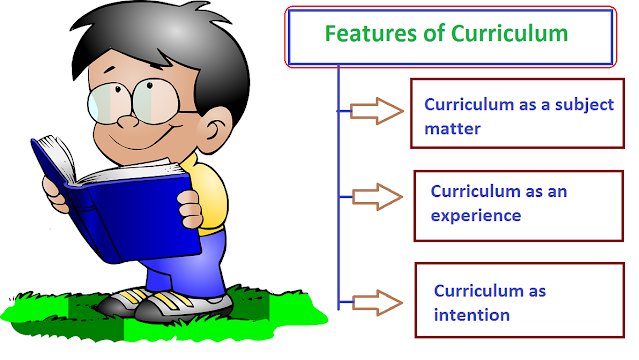Characteristics or features of the curriculum
As the traditional meaning of the curriculum seems to have taken its narrow concept, the traditional perception of the curriculum as a subject matter has changed. The curriculum is defined in a broad sense at a time when ideas are being communicated in favor of the appropriateness of the approach to take it as a teaching-learning plan. It has already been mentioned that it will include not only the subjects to be taught but also the objectives of teaching and learning, subjects, and planning of the teaching-learning process. Here the curriculum is interpreted in three ways: as a subject, as an experience, and as intended.Curriculum as a subject matter
The traditional approach is to interpret the curriculum as a list of topics to be taught to students. According to this approach, the curriculum includes teaching topics. The teacher should plan to teach this subject. The general public still understands this traditional notion of the curriculum. The curriculum is also considered as a subject matter to be studied in schools, campuses, and universities. In Nepal, as there was no systematic curriculum at the pre-school level in 2028 BS, the syllabus was considered as the curriculum. Even now, even if other aspects are included in the curriculum, there are approaches and practices that give special importance to the subject included in the curriculum.In the early days of human civilization, there were seven general arts subjects and the subject matter of those subjects were taken as a curriculum. It is found that such topics are divided into two parts as Trivium and Quadrivium. The Trivium section covered grammar, poetry, and debate, and the Quadrivium included arithmetic, geometry, astronomy, and music.
Even in the current school and higher education curriculum, the subject matter or topics to be included in it are considered important.
This curriculum approach seems to place more emphasis on theoretical knowledge than on the student learning process. For example, most people understand English, Nepali, Mathematics, Science, Social Studies, six compulsory and two elective subjects out of the eight subjects called secondary level curriculum. From a thematic point of view, the curriculum is taken as information about what is taught under it.
As the thematic approach of the curriculum carries only a narrow meaning of the curriculum, the perception that this approach is incomplete is having an effect on the general public. From this point of view, the curriculum determines the subject matter, and accordingly, the curriculum seems to be taken on the basis of the arguments of the teacher and the parties concerned to make necessary arrangements for the effective preparation of the teaching and learning activities.
Curriculum as an experience
Along with the discussion of the inadequacy of the traditional perception of the curriculum as a subject matter, in recent times the curriculum has been taken as a learning experience gained by the children in the context of educational activities. Although the curriculum formally specifies how to provide learning experiences to children, some experiences are gained through learning. In this way, when taking the curriculum as an experience, it is possible to provide experiences in the form of written and formal as well as missing course experiences.This concept refers to the experience that children gain after teaching and learning activities rather than the prescribed subject matter of the curriculum. According to this concept, the meaning of the curriculum is much wider than the subject matter. Under such a curriculum, the role of the teacher is to facilitate the victim or the personal growth of the child. In fact, such a concept of the curriculum encompasses the experience gained from practical application and activities rather than the theoretical knowledge of the subject matter. It provides an opportunity for students to actively participate in the teaching-learning process and gain continuous learning experience.
The curriculum also needs to mention how to provide learning experiences. In such a curriculum, there is a view that the learning experience gained from the school classroom, outside the school, and from the family and parents also affects the learning.
Curriculum as intention
During the curriculum plan, expectations/ intentions are prepared as to what changes can be expected from the implementation of the curriculum. Such expectations are included in the curriculum as goals and objectives of the curriculum. What kind of learning experiences are provided to the learners is determined before the implementation of the curriculum. In this way, the objective or expected learning experience is taken as a way to address the needs of the learner. In this sense, the curriculum is a description of the pre-implementation expectations.This approach to the course indicates two things. First, the curriculum contains statements of pre-determined expectations. It includes goals, objectives, and what students need to learn. Second, the pedagogy is a statement of expected learning experiences, which includes what the learner should actually achieve.
When interpreting the curriculum as an expectation or intention, it includes the expectations of a student and parents, school, society, and the nation as a whole. For example, national objectives, stratified objectives, thematic and class objectives of education are included as expectations. In the same way, the details of the learning experiences that the students get are also presented in the syllabus. Based on these expectations, other activities can be determined, content can be selected and evaluated.



0 Comments
If this article has helped you, please leave a comment.